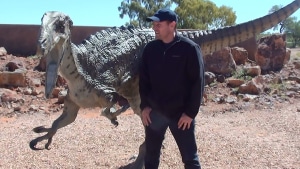
Bronze statue of ‘Banjo’ outside of AAOD Reception Centre, Winton QLD
Over the past 10 years there have been spectacular dinosaur fossils uncovered in central QLD. There is now a huge effort to create a natural history museum which showcases these Australian fossils in the environment in which they’ve been found. Australian Age of Dinosaurs Museum (AAOD) is spearheading this challenge, with the resolve to produce a world class dinosaur museum in the heart of central QLD. AAOD was founded in 2002 as a non-profit initiative following a public meeting in Winton. With help from all levels of government, corporate donations, and public support, AAOD has grown from a small display cabinet in downtown Winton to a multi-million dollar installation on a 1800 hectare site situated 75 m above a sprawling plain on a flat mesa called the ‘Jump Up‘.
The AAOD site already has a working fossil preparation laboratory, visitor reception area, fossil type room and guest lodgings with plans very much underway to build the Museum itself. Over the past year Fizzics has been working with the Sydney Chapter of AAOD on a concept of bringing AAOD to Australian schools through video conferencing and outreach. In August I was lucky enough to be invited along to visit a AAOD dinosaur dig in Winton, QLD. These digs are held annually whereby members of the public can participate in recovering fossil remains of sauropod and theropod dinosaurs under the black soil of the Winton formation.
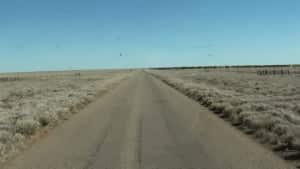
The road to the dinosaur dig site near Winton in Central QLD
People come from all over Australia to join the AAOD dinosaur digs and a huge variety of backgrounds. During the digs you work alongside paleontologists from both AAOD and Queensland Museum to ensure that the specimens are handled with care and precision. What a unique opportunity; people from a variety of backgrounds work with world class researchers on priceless natural artifacts! What is interesting about these digs is that due to their remote locality the participants camp nearby in a shearers mess hall. This adds to the camaraderie of the team and the evenings are fantastic as the resident palaeontologists run nightly talks about their work.
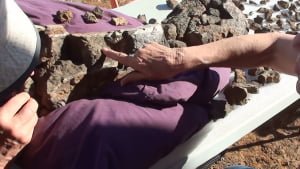
Putting together a sauropod bone at the dig site; spongy bone being highlighted
Working on a fossil dig site is a little like fishing; you’ve got a fairly good idea of where to look but it’s not always a guarantee you’ll find what you’re looking for. Generally the sites have been found by sheep farmers who have noticed some trace remains on the surface and have contacted AAOD. The soil overburden on the site is removed before the painstaking search for fossil begins. Fossil traces can range from tiny fragments through to almost complete bone specimens. Apart from working on the dig site I spent a couple of days putting together the jigsaw of a sauropod bone (pictured above).
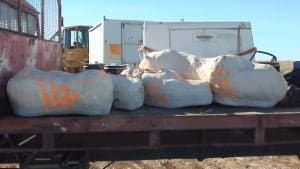
Plaster jackets containing fossils to be sent to AAOD Museum
Once found the fossils are placed in plaster jackets for transport back to the AAOD fossil preparation lab. The ‘prep lab’ has a huge of plaster jackets found on previous digs. Speaking with the staff they reckon there are years of work to prepare all of the stock material to museum-quality, yet there is still more fossil material to be found at the dig sites!
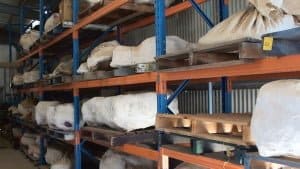
Racking filled with fossil plaster jackets at Australian Age of Dinosaurs Museum
To help with the sheer amount of material AAOD actively encourages museum visitors to become trained in removing some of the rocky matrix from specimens. This is a unique experience; normally these type of specimens are protected from the public and only removed behind closed doors or at least behind glass windows. Of course, this means that public helpers need to be closely watched and are only handed specimens that are heavily embedded in rock. As the rock changes colour, indicating bone discolouring the hardened soil due to oxidation, more experienced fossil preparers from the laboratory take over.
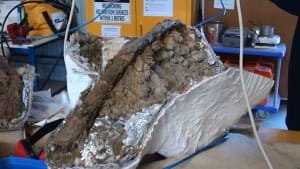
Sauropod rib bone surrounded by rocky matrix in AAOD laboratory
The work inside the laboratory is highly engaging, as you know that you are doing genuinely useful work that needs to occur before paleontologists can analyze the specimen.
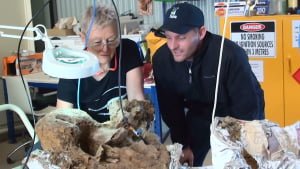
Removing rocky matrix from a sauropod vertebrae at AAOD
The rocky matrix material is removed by wen pens (aka scribes) which are engraving tools driven by compressed air. The sound of the fossil prep laboratory is akin to listening to bees, only much louder hence the need for ear protection. You work under bright light and magnifiers to make sure you only remove rocky material The fossil remains are protected by a hardening consolidant solution which penetrates the fossil to give strength. Fossil pieces are joined together with adhesive.
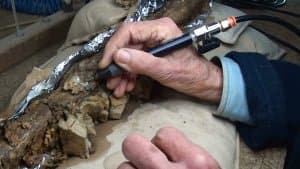
Using a wen pen to carefully remove rocky matrix from a fossil
If you want to follow the activities of the Australian Age of Dinosaurs Museum I highly recommend that you subscribe to their annual journals publication. These contain a huge amount of information on fossil finds, behind the scenes stories and upcoming developments in the building of an Australian natural history museum. You can also become a member of AAOD. To join the dinosaur digs check out the link!
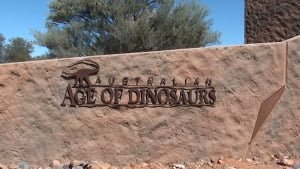
Australian Age of Dinosaurs reception centre sign
Happy teaching,
























Comments